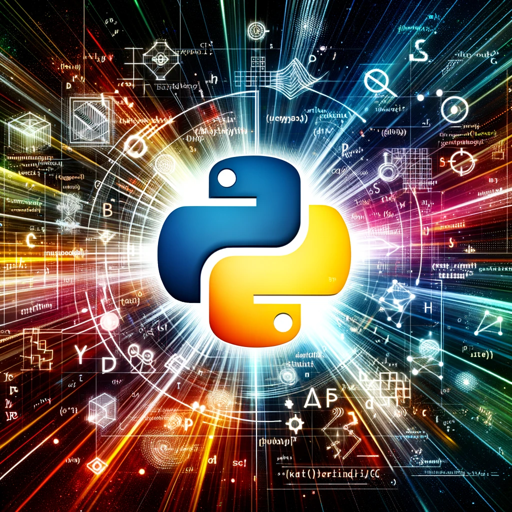Scientific Python-scientific data analysis tool
AI-powered data science with Python
🚗🤖 TensorFlow with streamlit for autonomous vehicles
🏥📈 Scikit-learn in healthcare for predictive modeling
🌌🔢 Show SymPy is solving theoretical physics problems
✈️💻 Create a Jupyter notebook for plane turbulence simulation
🌊🌠 How do NumPy and SciPy contribute to gravitational wave research?
💹📊 Explain how to use Pandas for complex financial data analysis?
🌳🗺️ What are the best ways to create environmental data visualizations using Matplotlib and Seaborn?
📸👁️ Explain a TensorFlow model for image recognition
💾📊 How do I use Pandas for data analysis?
🚀🌌 What's the process for setting up a Jupyter Notebook for space mission simulations?
🌍🖥️ Best practices in Python for network programming?
🧬🔬How does Biopython aid in genomic sequencing projects like the Human Genome Project?
Related Tools
Load More
Python
A Python assistant for all skills levels, pre-trained on https://www.python.org/ and https://stackoverflow.com/

Python
Help users develop more easily and quickly. Optimized for professional Python developers focusing on efficient and high-quality production code. Also enhanced for image tasks.

Python Quant
Friendly, professional Python Quant expert, making educated assumptions.

SCI Helper
协助我对论文进行高水平SCI发表所需的修改,包括语言润色、逻辑递进以及结果描述和讨论。

Python Data Analysis
I am an expert in Python Data Analysis, proficient in using advanced data analytics tools and techniques to extract meaningful insights from complex datasets.

Python Code Expert
Develop Python applications that are efficient, maintainable, testable, performant, and robust. Excels at OOP design, error handling, documentation, logging, and much more. Includes unit tests written in pytest for all code snippets.
20.0 / 5 (200 votes)
Introduction to Scientific Python
Scientific Python refers to a collection of Python libraries and tools designed specifically for scientific computing and data analysis. These libraries provide functionalities that range from numerical computations, data manipulation, and visualization to machine learning, symbolic mathematics, and bioinformatics. The primary design purpose of Scientific Python is to facilitate efficient, scalable, and easy-to-use scientific computing for researchers, scientists, and engineers. It leverages the expressive power of Python to create an ecosystem where complex scientific problems can be solved with minimal effort. Examples of Scientific Python libraries include NumPy for numerical computations, Pandas for data manipulation, Matplotlib for data visualization, and SciPy for advanced scientific computations.

Main Functions of Scientific Python
Numerical Computations
Example
Using NumPy for array operations and linear algebra.
Scenario
Researchers use NumPy to perform fast Fourier transforms, linear algebra operations, and statistical computations on large datasets. For example, a physicist might use NumPy to simulate particle interactions in a controlled environment.
Data Manipulation and Analysis
Example
Utilizing Pandas for data manipulation and analysis.
Scenario
Data scientists employ Pandas to clean, process, and analyze tabular data. For instance, an epidemiologist might use Pandas to analyze COVID-19 case data, identifying trends and patterns to inform public health decisions.
Data Visualization
Example
Creating visualizations with Matplotlib and Seaborn.
Scenario
Environmental scientists use Matplotlib and Seaborn to visualize climate data, creating plots and graphs that illustrate temperature changes over time. These visualizations help in communicating findings to both scientific communities and the general public.
Ideal Users of Scientific Python
Researchers and Scientists
Scientific Python is highly beneficial for researchers and scientists in fields such as physics, chemistry, biology, and engineering. These users benefit from the ability to perform complex numerical simulations, data analysis, and visualization, which are critical for experimental and theoretical research.
Data Scientists and Analysts
Data scientists and analysts across various industries, including finance, healthcare, and marketing, find Scientific Python indispensable. They use it for data cleaning, manipulation, statistical analysis, and machine learning, enabling them to extract insights from large datasets and make data-driven decisions.

How to Use Scientific Python
Visit aichatonline.org for a free trial without login, also no need for ChatGPT Plus.
Start by exploring the capabilities of Scientific Python through a free trial available at aichatonline.org. No login or subscription to ChatGPT Plus is required.
Install necessary libraries
Ensure you have Python installed. Install scientific libraries like NumPy, SciPy, Pandas, and Matplotlib using pip or conda. These libraries are essential for numerical computing, data manipulation, and visualization.
Set up your development environment
Use Jupyter Notebook or an IDE like PyCharm or VS Code for coding. These tools provide an interactive environment for running Python code, visualizing data, and documenting your analysis.
Learn from documentation and tutorials
Utilize official documentation and online tutorials for libraries like NumPy, SciPy, Pandas, and Matplotlib. Websites such as numpy.org, scipy.org, and pandas.pydata.org offer comprehensive guides and examples.
Practice with real-world data
Apply your knowledge by working on projects using real datasets. Websites like Kaggle offer datasets and competitions to enhance your skills in data science and scientific computing.
Try other advanced and practical GPTs
Greek Mythology
Discover the World of Greek Myths with AI

Academic Research Projects
AI-Powered Tool for Academic Excellence

Animals GPT
AI-powered insights into the animal kingdom

Hyperficient — Science-Backed Gym Coach
AI-Driven Muscle Growth Insights.
Coupon GPT
AI-powered discount finder

Deutschlehrer
AI-powered German language tutor and corrector

Book Quotes Finder
AI-powered book quote discovery.

Kalaallisut - dansk
AI-powered Greenlandic to Danish translation tool

ABAQUS CAE Tutor
AI-powered assistance for ABAQUS CAE

ABAQUS Scripting Tutor
AI-powered ABAQUS scripting assistant

Encoder
Empowering Developers with AI-Driven Code

CryptoDo - smart contract builder
AI-powered no-code smart contract builder

- Data Analysis
- Visualization
- Machine Learning
- Scientific Research
- Numerical Computing
Scientific Python Q&A
What is Scientific Python used for?
Scientific Python is used for numerical computing, data analysis, and visualization. It leverages libraries like NumPy for array operations, Pandas for data manipulation, and Matplotlib for plotting, making it ideal for scientific research and data science projects.
Which libraries are essential for Scientific Python?
Essential libraries for Scientific Python include NumPy for numerical computing, SciPy for advanced scientific computing, Pandas for data manipulation, Matplotlib and Seaborn for data visualization, and Scikit-learn for machine learning.
How do I visualize data using Scientific Python?
To visualize data, use Matplotlib for creating static plots and Seaborn for statistical graphics. Libraries like Plotly and Bokeh can be used for interactive visualizations. Start with simple plots and gradually explore advanced visualization techniques.
Can I use Scientific Python for machine learning?
Yes, Scientific Python is widely used for machine learning. Libraries like Scikit-learn provide tools for building and evaluating machine learning models. For deep learning, use TensorFlow or PyTorch, which offer extensive support for neural networks.
What resources are available for learning Scientific Python?
Resources include official documentation for libraries, online tutorials, books like 'Python Data Science Handbook' by Jake VanderPlas, and courses on platforms like Coursera, edX, and DataCamp. Additionally, explore forums like Stack Overflow for community support.